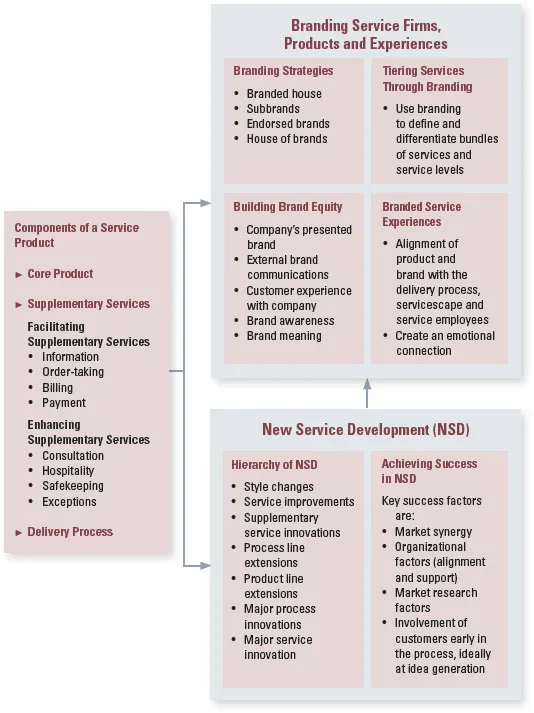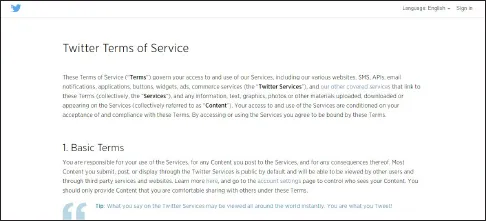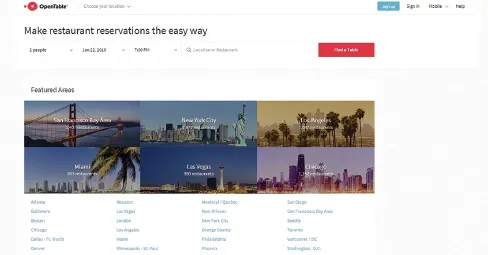![]()
VOLUME 3
Developing Service Products and Brands
Each and every one of you will make or break the promise that our brand makes to customers.
An American Express manager speaking to his employees
CREATING SERVICE PRODUCTS
In recent years, more and more service firms have started talking about their products — a term previously largely associated with manufactured goods. What is the distinction between these two terms in today’s business environment? A product implies a defined and consistent “bundle of output” as well as the ability to differentiate one bundle of output from another. In a manufacturing context, the concept is easy to understand and visualize. Service firms can also differentiate their products in a similar fashion using the various “models” offered by manufacturers. For example, fast-food restaurants display a menu of their products, which are, of course, highly tangible. If you are a burger connoisseur, you can easily distinguish Burger King’s Whopper from its Whopper with Cheese, or from McDonald’s Big Mac.
Providers of more intangible services, also offer various “models” of products, representing an assembly of carefully prescribed value-added supplementary services built around a core product. For instance, credit card companies develop different cards each with a distinct bundle of benefits and fees; insurance companies offer different types of policies; and universities offer different degree programs, each composed of a mix of required and elective courses. The objective of product development is to design bundles of output that are distinct and can be easily differentiated from another.
All service organizations face choices concerning the types of products to offer and how to deliver them to customers. To better understand the nature of services, it is useful to distinguish between the core product and supplementary elements that facilitate its use and enhance its value for customers. Designing a service product is a complex task that requires an understanding of how the core and supplementary services should be combined, sequenced, and delivered to create a value proposition that meets the needs of target segments (Figure 1).
What are the Components of a Service Product?
What does a service “product” mean? Service performances are experienced rather than owned. Even when there are physical elements to which the customer takes a title of ownership — such as a meal (which is promptly consumed), a surgically implanted pacemaker, or a replacement part for a car — a significant portion of the price paid by customers is for the value added by the service elements, including expert labor, and the use of specialized equipment. A service product comprises all the elements of service performance, both physical and intangible that creates value for customers.
How should a service product be designed? Experienced service marketers recognize the need to take a holistic view of the entire performance that they want customers to experience. The value proposition must address and integrate three components: (1) core product, (2) supplementary services, and (3) delivery processes.
Figure 1: Organising Framework
Core Product
The core product is “what” the customer is fundamentally buying. When buying a one-night stay in a hotel, the core service is accommodation and security. When paying to have a package delivered, the core service is that the package arrives at the correct address, on time, and undamaged. In short, a core product is the central component supplying the principal benefits and solutions that customers seek. The core product is the main component that supplies the desired experience (e.g., a rejuvenating spa treatment or an exhilarating roller coaster ride) or the problem-solving benefit (e.g., a management consultant provides advice on how to develop a growth strategy, or a repair service restores a piece of equipment to proper working condition) that customers are looking for.
Some core products are highly intangible. For example, credit card and travel insurance products and their innovative design of features, benefits and pricing (note that many fees are hidden transaction costs, especially if used abroad). Equally, if not more intangible, are exchange traded funds (ETFs) which revolutionized the mutual fund industry. An ETF is essentially a low-cost mutual fund that usually tracks an index (e.g., the Dow Jones or Nikkei 225) and is listed on a stock exchange so that investors can trade in and out as they like. These funds are cheap, tax-efficient, and allow retail investors to buy a diversified portfolio. The development of ETF products has been an exciting journey with major product innovation involved.1
Supplementary Services
Delivery of the core product is usually accompanied by a variety of other service-related activities collectively referred to as supplementary services, which augment the core product, both facilitating its use and enhancing its value. Core products tend to become commoditized as an industry matures and competition increases. So the search for competitive advantage often emphasizes supplementary services, which can play an important role in differentiating and positioning the core product against competing services.
Delivery Processes
The third component in designing a service concept concerns the processes used to deliver both the core product and each of the supplementary services. The design of the service offering must address the following issues:
Figure 2: Depicting the service offering for an overnight hotel stay
•How the different service components are delivered to the customer.
•Nature of the customer’s role in those processes.
•How long delivery lasts.
•Prescribed level and style of service to be offered.
The integration of the core product, supplementary services, and delivery processes is captured in Figure 2, which illustrates the components of the service offering for an overnight stay at a luxury hotel. The core product — overnight rental of a bedroom — dimensioned by service level, scheduling (how long the room may be used before another payment becomes due), nature of the process (in this instance, people processing), and the role of customers (in terms of what they are expected to do themselves and what the hotel will do for them, such as making the bed, supplying bathroom towels, and cleaning the room).
Surrounding the core product is a variety of supplementary services ranging from reservations to meals to in-room service elements. Delivery processes must be specified for each of these elements. The more expensive the hotel is, the higher the level of service is required of each element. For example, very important guests might be received at the airport and transported to the hotel in a limousine. Check-in arrangements can be done on the way to the hotel. By the time the guests arrive at the hotel, they are ready to be escorted to their rooms, where a butler is on-hand to serve them. The service process aspect is discussed in detail in Volume 6. This volume focuses on core and supplementary services, branding, and new product development.
FLOWER OF SERVICE
The Flower of Service consists of the core service and a range of supplementary services. There are potentially dozens of different supplementary services, but almost all of them can be classified into one of the following eight clusters shown in Figure 3, identified as either facilitating or enhancing: (1) facilitating supplementary services are required for either service delivery (e.g., making a reservation) or aiding in the use of the core product (e.g., information), and (2) enhancing supplementary services add extra value and appeal for customers (Figure 2) — for example, consultation and hospitality can be very important supplementary services in a health care context.
Figure 4 shows eight clusters displayed as petals surrounding the center of a flower. The petals are arranged in a clockwise sequence starting with “information,” following the order they are likely to be encountered by customers. In a well-designed and well-managed service product, the petals and core are fresh and well-formed. A badly designed or poorly delivered service is a like a flower with missing, wilted, or discolored petals. Even if the core is perfect, the flower looks unattractive. Think about your own experiences as a customer (or when buying on behalf of an organization). When you were dissatisfied with a particular purchase, was it the core that was at fault, or was it a problem with one or more of the petals?
Figure 3: Facilitating and enhancing services provide value to the core product
Figure 4: The Flower of Service: Core product surrounded by cluster of supplementary services
Facilitating Supplementary Services
Information
To obtain full value from any good or service, customers need relevant information, which includes the following:
•Direction to service site
•Schedules/service hours
Figure 5: Twitter.com provides conditions of service to users
•Price information
•Terms and conditions of sale/service (Figure 5)
•Advice on how to get the most value from a service
•Warnings and advice on how to avoid problems
•Confirmation of reservations
•Receipts and tickets
•Notification of changes
•Summaries of account activities
New customers are especially information-hungry. Companies should make sure the information they provide is both timely and accurate. If not, it is likely to cause customers inconvenience, make them feel irritated, and perceive a lack of control.
Traditional ways of providing information include using company websites, mobile apps, front-line employees, signs, printed notices, and brochures. Information can also be provided through videos or software-driven tutorials, touch-screen video displays on tablets and self-service machines.
Order-Taking
Once customers are ready to buy, a key supplementary element comes into play — order-taking. Order-taking includes:
•Order entry
Figure 6: Websites like OpenTable take dining reservations to a whole new level by allowing diners to bypass the traditional call-and-book experience, with a mere click
–On-site order entry
–Mail/telephone/e-mail/online/mobile app order
•Reservations or check-ins
–Seats/tables/rooms
–Vehicles or equipment rental
–Professional appointment
•Applications
–Memberships in club/programs
–Subscription services (e.g., utilities)
–Enrolment-based services (e.g., financial credit, college enrolment)
Order entry can be received through...






